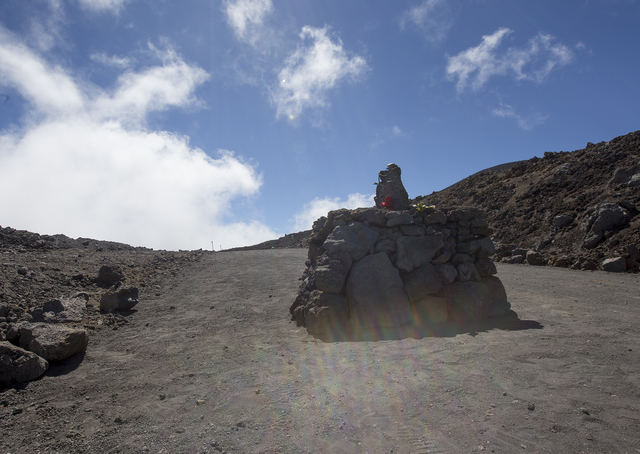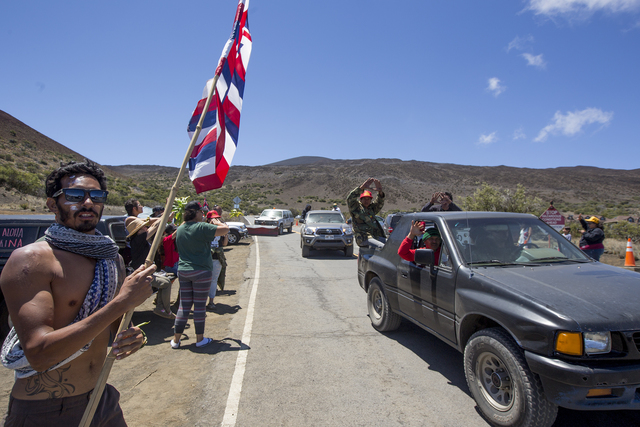The struggle for access to Mauna Kea continued Thursday during a hearing in Judge Ronald Ibarra’s Environmental Court. ADVERTISING The struggle for access to Mauna Kea continued Thursday during a hearing in Judge Ronald Ibarra’s Environmental Court. The case is
The struggle for access to Mauna Kea continued Thursday during a hearing in Judge Ronald Ibarra’s Environmental Court.
The case is a challenge to the emergency rule preventing people being on the access road or within one mile of either side from 10 p.m. to 4 a.m. and prevents camping supplies being held in the area.
The court case ran from noon until shortly before 5 p.m. as both sides called witnesses and introduced evidence.
The first witness was Kalani Flores, an assistant professor of Hawaii Life Styles at Hawaii Community College and Native Hawaiian.
He wanted to expand “the understanding that the mountain is a sacred temple,” he said.
That comes from generations of communion with ancestors, ancestral guides and divine beings, he said.
Communion with family members, ancestors and guides, sometimes includes directions and to which rituals to perform, when to do so and where they must be done.
“The practices are site-specific,” he said, including on Mauna Kea.
That sometimes includes directions from the ancestors or divine beings as to what rituals to perform, he said and when and where to do so.
These can be at places built by their ancestors or places that believers are guided to, he said.
The process up the mountain includes stops to blow the shell horn, give prayers and ask for permission to continue.
“This is like a basic foundation of Hawaiian common practice — asking permission, giving your intentions and giving gratitude,” he said.
One of the important shrines on the trip is within the excluded area, he said, along with other important ritual sites.
It’s impossible to say when there is a time to go up the mountain, he said, as it depends on the directions given to them.
For Hawaiians, the equinox and solstices are especially important, said Clarence Ching, a Native Hawaiian and resident of Waimea. He said he has often visited the mountain as part of his spiritual, emotional and religious life.
One ritual is performed to welcome the sun arriving, Ching said. To do that, his group will leave Hilo at 10 p.m., making its way across the island and up the mountain to be at the summit before sunrise, often well before 4 a.m.
They also engage in more frequent activities, including long walks around the mountain that can take all day. Sometimes they do not make it to their finish point until dark, he said. Other nights they are delayed and for safety reasons have to sleep on the mountain, he said. As a result, some carry equipment barred under the rule as insurance, he said.
“I’m hoping to (walk) this next month, at equinox time,” he said.
“Not being able to be on Mauna Kea on an equinox would be like a Christian not being able to attend the sunrise Easter service they have every year,” Flores said.
The next equinox is on Sept. 22, which Ibarra acknowledged as a concern in the speed of the case. He said he also wanted as much input as possible before a decision.
Chief Ranger Paul “Scotty” Paiva said he was concerned by how many people are now near the road, which is twisted, studded with blind corners and slick. He’s seen children playing in the road, people sitting in lawn chairs with their feet on the pavement and campers near the roadway. With the risk of brake failure on a descending vehicle, any of those people could be struck, he said.
“Just on Wednesday I saw one of them doing push-ups in the makai lane, facing makai,” he said.
There is also safety of the environment to think of, he said. The coconuts, bananas and other plant matter could all bring invasive species up to the area, he said. That risk was confronted once, when the bamboo used to build a structure was found with ants in it.
The state focused on the safety concerns caused by the recent protest, particularly the rocks moved on to the road.
Scattered stones, walls and rocks were seen on the roadway after the protesters moved off, according to testimony.
These walls were reconstructed after Paiva and several officers went up to get everyone off the summit. Paiva said their small column was trapped by a wall. Protesters created a serpentine path through the barrier to allow them to leave and the protesters rebuild the barrier, he said.
The attorneys have until the close of business Aug. 28 to submit materials. It is unknown what date there will be further action.




